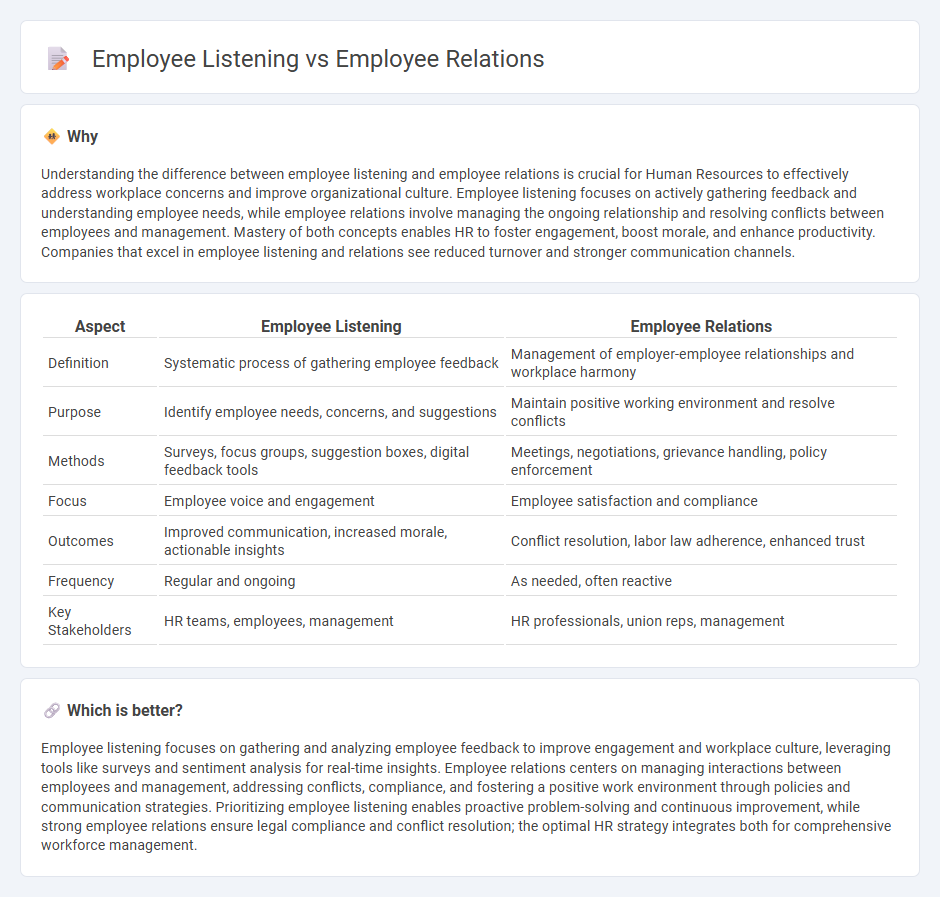
Employee listening involves gathering, analyzing, and acting on feedback from employees to enhance engagement and workplace satisfaction. Employee relations focus on managing the employer-employee relationship, resolving conflicts, and ensuring compliance with labor laws. Explore how integrating employee listening strategies can strengthen overall employee relations and organizational culture.
Why it is important
Understanding the difference between employee listening and employee relations is crucial for Human Resources to effectively address workplace concerns and improve organizational culture. Employee listening focuses on actively gathering feedback and understanding employee needs, while employee relations involve managing the ongoing relationship and resolving conflicts between employees and management. Mastery of both concepts enables HR to foster engagement, boost morale, and enhance productivity. Companies that excel in employee listening and relations see reduced turnover and stronger communication channels.
Comparison Table
| Aspect | Employee Listening | Employee Relations |
|---|---|---|
| Definition | Systematic process of gathering employee feedback | Management of employer-employee relationships and workplace harmony |
| Purpose | Identify employee needs, concerns, and suggestions | Maintain positive working environment and resolve conflicts |
| Methods | Surveys, focus groups, suggestion boxes, digital feedback tools | Meetings, negotiations, grievance handling, policy enforcement |
| Focus | Employee voice and engagement | Employee satisfaction and compliance |
| Outcomes | Improved communication, increased morale, actionable insights | Conflict resolution, labor law adherence, enhanced trust |
| Frequency | Regular and ongoing | As needed, often reactive |
| Key Stakeholders | HR teams, employees, management | HR professionals, union reps, management |
Which is better?
Employee listening focuses on gathering and analyzing employee feedback to improve engagement and workplace culture, leveraging tools like surveys and sentiment analysis for real-time insights. Employee relations centers on managing interactions between employees and management, addressing conflicts, compliance, and fostering a positive work environment through policies and communication strategies. Prioritizing employee listening enables proactive problem-solving and continuous improvement, while strong employee relations ensure legal compliance and conflict resolution; the optimal HR strategy integrates both for comprehensive workforce management.
Connection
Effective employee listening fosters open communication channels that strengthen employee relations by addressing concerns promptly and enhancing workplace trust. Employee listening tools like surveys and feedback platforms enable HR to identify issues early, promoting proactive conflict resolution and boosting overall employee engagement. Strong employee relations, in turn, create an environment where employees feel valued and heard, driving higher productivity and retention rates.
Key Terms
**Employee Relations:**
Employee relations centers on managing the employer-employee relationship by addressing workplace conflicts, ensuring policy compliance, and fostering a positive organizational culture. It involves proactive conflict resolution, thorough communication of company policies, and strengthening employee engagement to enhance productivity and retention. Explore how effective employee relations strategies can transform your workplace dynamics for sustained success.
Conflict Resolution
Employee relations emphasizes managing and resolving workplace conflicts through formal policies and communication channels, ensuring legal compliance and maintaining organizational harmony. Employee listening prioritizes gathering employee feedback, perceptions, and concerns via surveys, focus groups, or one-on-one conversations to identify underlying issues before conflicts escalate. Explore how integrating both strategies enhances conflict resolution and fosters a healthier work environment.
Labor Law Compliance
Employee relations primarily centers on managing workplace interactions within the framework of Labor Law Compliance, ensuring adherence to regulations such as the National Labor Relations Act (NLRA) and Occupational Safety and Health Administration (OSHA) standards. Employee listening involves implementing feedback mechanisms like surveys and suggestion programs to identify concerns proactively, promoting a compliant and positive work environment. Discover how integrating employee relations strategies with effective listening practices can strengthen legal compliance and workplace harmony.
Source and External Links
Employee Relations: A Critical Area of HR Management - Employee relations involve creating and maintaining positive connections between management and employees to improve communication, resolve conflicts, build morale, and foster loyalty within a company culture, distinct from labor relations focused on union legalities.
Mastering Employee Relations - Employee relations focus on preventing and resolving disputes between employees and management, maintaining fair policies, and managing both vertical (manager to employee) and horizontal (peer to peer) relationships to cultivate respect and collaboration.
Employee Relations: Examples + 10 Strategy Tips - Employee relations manages the employer-employee relationship to foster trust, respect, and appreciation, building a strong company culture and enhancing overall organizational performance through specialized HR functions focused on employee experience.
 dowidth.com
dowidth.com